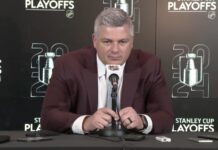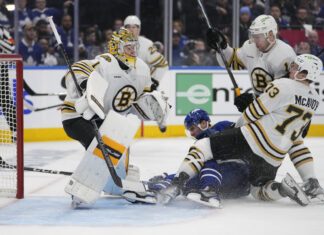As summer enters the dog days and the Toronto Maple Leafs’ offseason looks more or less complete, I can’t help but think of a Lou Lamoriello quote from Behind The Moves:
“We traded Brendan Morrison because we had Scott Gomez coming… It wasn’t that we didn’t like Morrison; it’s just that we just felt that we needed a certain type of player… We didn’t re-sign Bobby Carpenter, because we felt John Madden was ready from the minors… We brought Colin White up for 10 games, and he showed he could play, but he wasn’t going to play [regularly] because we had Lyle Odelein… I had to keep Whitey playing, so we sent him to the minors. He sat right there and I said, ‘Listen, you could stay, but until we make room, I can’t have you not playing here [in New Jersey].’ We traded Odelein about 15 games later, and White never left… So those [moves] are all part of what you have in your mind and what your plan is that nobody else knows. Remember, the unknown – what you know – is the most dangerous. You’ve got to be careful because everybody wants to be privy to you.”
If the NHL season started tomorrow, none of Kasperi Kapanen, Josh Leivo or Nikita Soshnikov would be in the Leafs‘ starting 12 forwards. Zach Hyman, who just signed long-term, would be the most likely candidate to play on the fourth line with Matt Martin and Dominic Moore. None of that smells right.
Kapanen played well for the Leafs down the stretch and showed he is ready for a long, full-time look. Soshnikov was a full-time player before an injury, trades and the play of Kapanen bumped him out. A few months ago, the Leafs used an expansion spot to protect Leivo after 10 points in 13 games last season.
Earlier in the summer, we discussed the Leafs big pay days coming for Auston Matthews, William Nylander and Mitch Marner, and how that is going to start squeezing out talent. The most likely early candidates are James van Riemsdyk and Tyler Bozak, both of whom will be UFAs next summer, while Leo Komarov is another candidate as his contract also expires after this season.
In the last few months, JVR has been all over the rumour mill, including a potential deal to the Islanders for Travis Hamonic. It has been well documented at this point, but trading JVR makes the most sense in that the Leafs likely won’t be able to afford him next summer. Secondarily, it will open up a spot for a youngster, although they would miss JVR’s reliable high-end production. It hasn’t been pointed out often enough that he was ninth among Leafs forwards in playoff ice time – that speaks to Mike Babcock’s level of trust in the 28-year-old.
I know that the Leafs did float his name out there rather quietly last year, but they did not receive the type of offers they had hoped for.
That puts the Leafs in a bit of an awkward spot. As each day goes by, JVR gets closer to becoming a UFA and his value decreases accordingly. Toronto could do worse than hold onto a player that just posted a 62-point season without needing top minutes to do it, but losing him for nothing is not ideal, particularly if he has another productive season.
Lou Lamoriello won’t deal from a position of weakness here and he will happily wait it out while reaping the benefits of the JVR-Bozak-Marner line yet again. But he knows the defence isn’t good enough unless prospects suddenly emerge, and the organization surely doesn’t want to get into the habit of letting good players leave for nothing as the cap tightens each summer. At the same time, they also need to start succession planning and graduating players that are ready for long looks with the big club.
This summer, Mike Babcock said the Leafs have, “too many good players for the 23 spots,” and Lamoriello reiterated that by noting, “we don’t have room for a lot of them.” They are well aware of the situation and will want to integrate the next crop of young players banging at the door, but how it all plays out remains to be seen.
Sophomore Slumps
The Leafs boasted an unprecedented rookie class in the modern era in 2016-17, featuring three players that reached the 60+ point mark. The 1980-81 Quebec Nordiques are the only other team in the league that can claim to have done it. Since the 2005 season, only 14 rookies in the league have hit the 60-point barrier (not including this past season). With that in mind, I figured I’d take a look at how they all did the following season:
| Player | Age | Rookie Points | Rookie PPG | Rookie SHG | Year 2 Point Difference | Year 2 PPG Difference | Year 2 SHG Difference |
|---|---|---|---|---|---|---|---|
| Sidney Crosby | 18 | 102 | 1.26 | 278 | 18 | 0.26 | -28 |
| Alex Ovechkin | 20 | 106 | 1.31 | 425 | -14 | -0.19 | -33 |
| Brad Boyes | 23 | 69 | 0.84 | 203 | -23 | -0.27 | -21 |
| Evgeni Malkin | 20 | 85 | 1.09 | 242 | 21 | 0.2 | 30 |
| Paul Stastny | 21 | 78 | 0.95 | 185 | -7 | 0.13 | -47 |
| Anze Kopitar | 19 | 61 | 0.85 | 193 | 16 | 0.09 | 8 |
| Patrick Kane | 18 | 72 | 0.88 | 191 | -2 | 0 | 63 |
| Niklas Backstrom | 20 | 69 | 0.84 | 153 | 19 | 0.23 | 21 |
| Jeff Skinner | 18 | 63 | 0.77 | 215 | -19 | -0.09 | -5 |
| Nathan MacKinnon | 18 | 63 | 0.77 | 241 | -25 | -0.18 | -49 |
| Mark Stone | 22 | 64 | 0.8 | 157 | -3 | 0.01 | -6 |
| Johnny Gaudreau | 21 | 64 | 0.8 | 167 | 14 | 0.19 | 50 |
| Filip Forsberg | 20 | 63 | 0.77 | 237 | 1 | 0.01 | 10 |
| Artemi Panarin | 24 | 77 | 0.96 | 187 | -3 | -0.06 | 24 |
If you’re looking for sophomore slumps here, the two big ones happened during injury-plagued seasons (Skinner and MacKinnon, even Stastny), while another was traded three-quarters of the way through the season (Boyes).
The biggest question for the production of Matthews, Nylander and Marner (other than staying healthy) might come down to ice time and deployment. Last season, Matthews led all forwards in ice time, Marner was third, and Nylander was eighth; for long stretches, each player played on a separate line as Babcock spread out the attack. As of right now, they are returning all of their key forwards and have added Patrick Marleau, which will only make ice time even harder to come by. Finding a good balance in order to keep everyone rolling will be a key factor this season.
If one other thing stands out in particular, it’s that Nylander was so low in ice time among forwards and almost half of his points came on the PP (26/61).
What’s the plan on defence?
It was not surprising to hear Mike Babcock say that the plan is to play Morgan Rielly with Ron Hainsey. It is not so much a comment on Hainsey and how good they think he may or may not be, but more to do with how Rielly and Nikita Zaitsev performed as a pairing for large parts of the season. Together, Rielly – Zaitsev had a 48.7CF% and had a goals percentage for of 40.5%; they received hard matchup minutes together, so that has to be taken into account, but often they looked in over their heads and committed glaring mistakes leading to goals. After a particularly rough game in March against Florida, Babcock finally saw enough and split the two apart: “We thought it was time. The puck was going in the net. We probably waited too long. I don’t know if it’s a better pair, but sometimes change is a good thing.”
When Zaitsev played with Gardiner in tough minutes, they posted a 47.7CF% but managed a goals for percentage of 56%.
Hainsey has turned into a serviceable veteran that can play both sides and generally receives tough defensive minutes in all situations. He made an interesting comment that the Leafs play similar to Carolina (Babcock and Canes coach Bill Peters coached together in Detroit), but how his slower, methodical game meshes with the always-on-the-go Rielly remains to be seen.
Beyond the locked-in top four, it has not received much attention that Martin Marincin is the only other lefty with legitimate NHL experience in the organization. The Leafs also have right handers Alexey Marchenko and Connor Carrick under contract – Carrick figures to have the upper hand there – to go along with Marlies like Travis Dermott and new signings like Andreas Borgman and Calle Rosen from Sweden. That entire third pairing is up for grabs, but based on experience, Marincin – Carrick could start if everyone else simply needs more time.
Sustainable Goaltending
With all the rookie hype throughout the season and the flashy Patrick Marleau signing in the summer, it’s easy to forget that Frederik Andersen put together a fantastic season, starting 66 games with a .918 save percentage. The team tried to upgrade their backup position in case of any injuries or regression from Andersen by trying to sign Mike Condon. When that failed, they circled back on Curtis McElhinney, who was good in Toronto but generally has been a below-average backup goalie – in his previous season in Columbus, he posted a .890 save percentage and is at .905 over his career.
Andersen has been good throughout his NHL career so far, with the primary caveat being health. If he stays healthy, there is no reason to think he can’t continue to be a solid starting goaltender, but on a team that didn’t particularly improve their defense after giving up the third most shots against in the league, it promises to be another heavy workload for him in 2017-18. Last year, Babcock said, “We’d like a backup to play 20 games if we could,” so if McElhinney reverts back to his career norm, that could put Toronto in another backup goalie dilemma.
Final Summer Word
All is quiet in the hockey world right now, let alone the Leafs world. I am travelling for the next few weeks, and hope everyone has a fantastic final few weeks of summer. See you when training camp rolls around!


































